14 Ingredient Swaps That Will Make Fried Chicken So Much Better
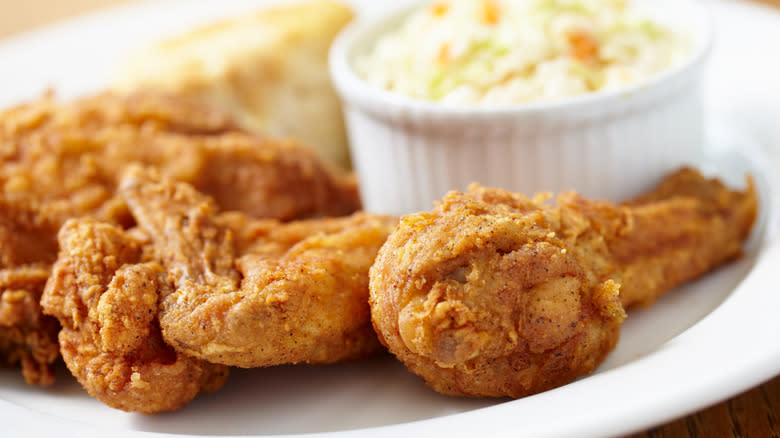
Is it possible to improve on perfection? If that perfection is fried chicken, the answer is yes. Fried chicken may be delicious using a standard recipe, but with just a few swaps in that recipe, you can produce an even better result. Although this dish may be a classic, thanks to its combination of crunchiness, juiciness, salt, and fat, it can become pretty monotonous, and mixing up its ingredients can give you a brand-new experience.
If you're thinking that fried chicken is made from just a few ingredients, too, that's where you'd be mistaken. This dish is a collection of a surprisingly large number of items, from its brine to its egg wash to its seasoning blend, and the choice of breading. There's also the oil you cook it in to consider -- which is an ingredient in its own right -- and has a huge impact on your chicken. You can make canny swaps with all of these ingredients to produce different flavor combinations, alternative textures, and even more deliciousness -- and some of the items you can use instead of your standard recipe are pretty exciting. Intrigued about how to make your fried chicken the best it's ever been? Let's go.
Read more: The 15 Best Frozen Chicken Nuggets, Ranked
Swap Regular Flour For Chickpea Flour
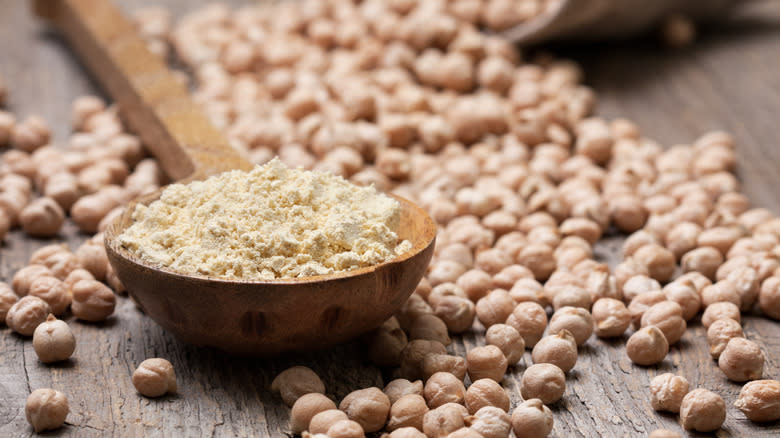
Wheat flour is a standard ingredient in fried chicken recipes, and its coating produces your meal's signature crunch. However, there are other ways to achieve this while giving your chicken a more idiosyncratic flavor. Swapping regular flour for chickpea flour can give fried chicken a slightly nutty flavor, and a hint of maltiness that works excellently with the juicy meat.
Chickpea flour is commonly used to make deep-fried dishes in Indian cuisine. Also known as gram flour, it's one of the main ingredients for pakora and produces a light crust that stays crunchy once it's pulled out of the oil. Chickpea flour is also more nutritionally dense than regular flour, containing higher levels of protein and fiber and an impressive mineral content.
Swapping regular flour for chickpea flour is pretty much a straight substitution. You don't have to worry about different quantities or measurements -- use it exactly as you would your regular flour, dredging your chicken before deep-frying it. If you want to add even more crunch, you can also spike your chickpea flour with some sesame seeds, which will give your chicken added nuttiness and savoriness.
Instead Of An Egg Wash, Use Mayo
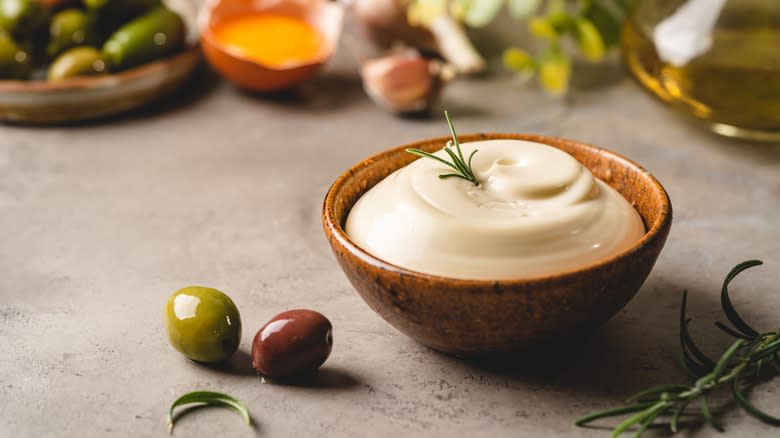
Making an egg wash is hardly difficult, but it's also not particularly exciting. So, next time you want perfect crispy chicken, replace that egg wash with mayo -- we guarantee it'll give you a more thrilling result. Mayonnaise is, after all, a kind of heightened egg wash, as it uses eggs as a base ingredient. However, it also throws a host of other flavors into the mix, giving your chicken even more tang, saltiness, and smoothness.
Mayonnaise's thick consistency also means it's effective at locking in your fried chicken's moisture. When it hits the hot heat of your deep-fryer, its inner juices are better protected, giving you a way more mouthwatering result. Plus, its tacky consistency gives your flour or breadcrumbs the perfect texture to cling to, increasing the amount of breading your chicken can take (and therefore, the amount of crunch you get when it's cooked).
Just make sure you're not being too heavy-handed with your mayonnaise. If you add too much to your chicken, you'll get a claggy, smushed-up result that tastes like mayo. Go for a light coating on your meat, enough for the breading to stick, but not so much that you can't see the chicken anymore.
Rather Than Dried Herbs, Use Curry Spices
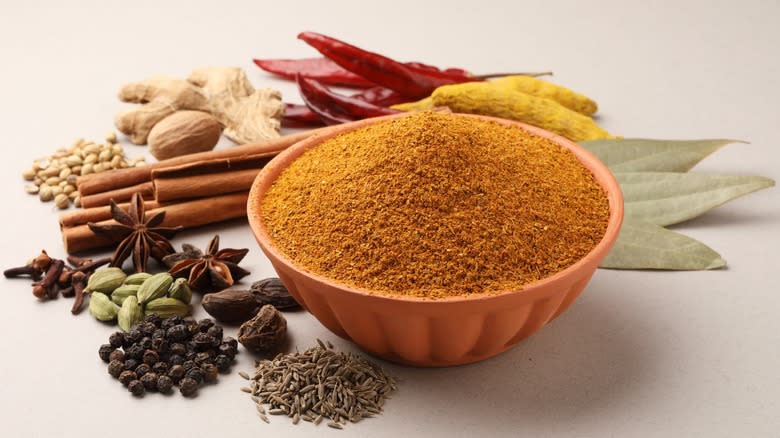
KFC's infamous, secret blend of 11 herbs and spices has been emulated in kitchens more times than we can count. But in our opinion, you should skip the attempts to copy it and use curry spices instead. Throwing curry spices into your fried chicken gives your food an enormous amount of complexity. When the spices hit the hot oil, they come alive with flavor and aroma, increasing the chicken's savory qualities and giving it a warmth you don't get from herbs.
You can use any spices you like here but remember the essentials. Coriander, cumin, turmeric, and fenugreek are all classic curry spices that give your chicken depth, earthiness, and rich color. Cloves and cardamom, meanwhile, will imbue your fried chicken with a richly-scented, almost perfumed warmth. To use your spices, dust them into your flour coating, mix everything, then dredge your chicken. You can also dust your spices into any marinade you're soaking your chicken in, to help them work their way into the meat. If you're only including them in your flour coating, we recommend using ground spices instead of whole ones. Ground spices will distribute your flavors more evenly, giving each bite the biggest impact possible.
Skip The Pickle Juice — Use Kimchi Instead
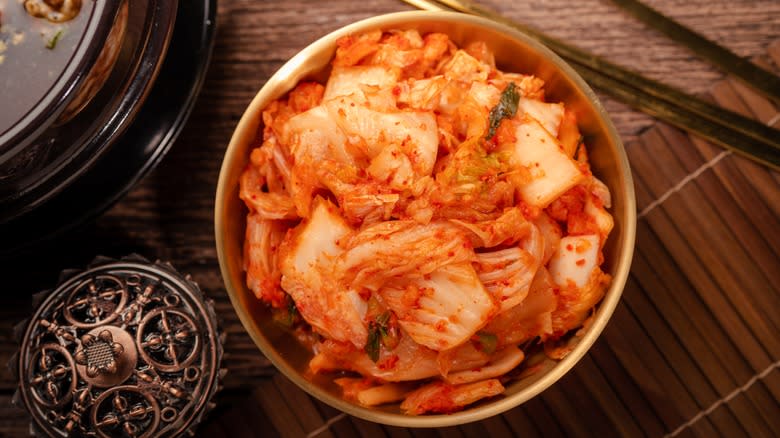
Somewhere down the line, pickle brines became a standard part of fried chicken recipes. It makes sense: These brines are full of salty, spicy flavors, and they fill your meat with these tastes while also helping keep it juicy and moist. Pickle brine is also pretty readily available, and using it is a great way to reduce food waste and utilize those leftovers in your pickle jar.
In our opinion, though, you need to consider brining your fried chicken in kimchi. Kimchi does pretty much everything that pickle juice does, just with added punch and a double dose of fermented saltiness and piquant spices. The combined effect of the kimchi's acidity and saltiness unravels the proteins in your chicken, adding to its juiciness, and giving them space for the spicy flavors to permeate. The combination of gochugaru (chili powder), fish sauce, ginger, and garlic gives the chicken more layers than you could imagine, and they go flawlessly with the crunchy coating.
As with pickle juice, using kimchi to brine chicken is a canny method for using the juices left in your jar once you've munched your way through the cabbage. You can also drain the juice out of a full jar of kimchi, and pour it over your chicken -- no need to wait until you've eaten all of the kimchi to do so.
Forget The Water And Add Beer To Your Batter
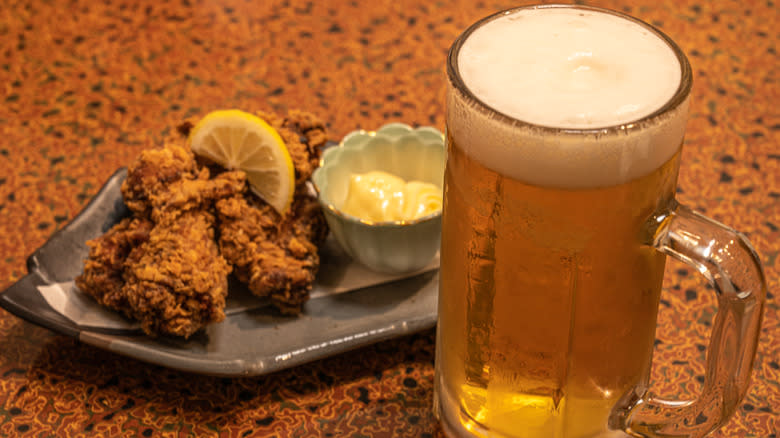
Making beer-battered fried chicken is delightfully easy: You just coat it with a flour and water combination, fry it, and eat. However, this method can be, dare we say, a little boring. You can rectify this easily, adding flavor and tenderness, by swapping your water for beer.
Using a beer batter helps you avoid the main issue with fried chicken: A heavy, soggy coating. This is thanks to the drink's unique combination of CO2, foaming agents, and alcohol. When a beer batter comes into contact with searing oil, its CO2 bubbles puff up, creating pockets of air in the batter. These bubbles are prevented from bursting by the beer's foaming agents, which insulate them. The alcohol, meanwhile, dries out the batter quickly, leaving it crispy and tender.
Not only this, but beer gives your batter a mellow, savory flavor, and a darker brown hue, which makes your fried chicken attractive to look at and taste. All you need to do is combine it with flour in place of your water, add your chosen seasonings, and dip your chicken in.
Swap Breadcrumbs For Parmesan
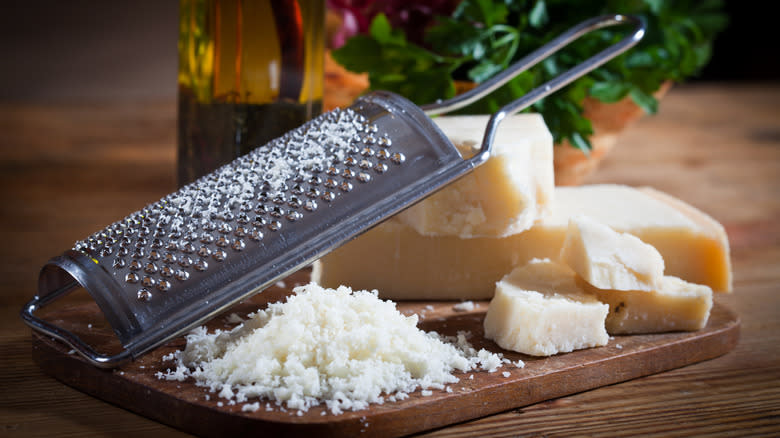
Breaded fried chicken is usually flavorful enough, but there's a surefire way to make it even tastier: Instead of breadcrumbs, use shredded parmesan. By coating your fried chicken with cheese, you can give it an intensely savory flavor, and produce a similar level of crunch to breadcrumbs. Parmesan is the ideal coating cheese due to its firmness and relatively low moisture content. When fried, it dries out more quickly, producing a crispiness you wouldn't get with other cheeses.
When using parmesan, though, it's useful to be careful. Cook it for too long, and it will burn, turning acrid and bitter. Parmesan can also have an unfortunate knack for falling off your chicken easily, so make sure that you coat it in plenty of egg wash. Pan-fried parmesan-crusted chicken tends to be easier to make than deep-fried parmesan chicken, as the coating will be less likely to flake off in your oil. If you like, you can also combine parmesan with breadcrumbs, to give your chicken extra crunch while still providing that savory, cheesy flavor.
Instead Of Eggs, Use Heavy Cream
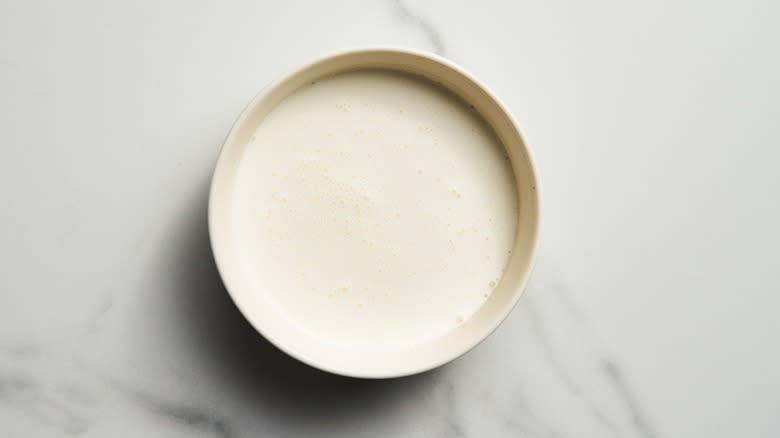
Egg washes are pretty essential to the success of your fried chicken, as they give your coating something to cling to. There's an even better way to help it stick to your chicken, though -- use heavy cream instead. Heavy cream gives your chicken a smoothness and a rich flavor while remaining sticky enough to hold breadcrumbs or seasoned flour in place. It's also a great option for folks who can't eat eggs, and arguably way easier to use than an egg wash: Instead of having to beat your eggs, you just pour your cream into a bowl, and you're ready to go.
Using heavy cream is similar to using a buttermilk brine for your chicken, with the difference being that heavy cream has less acidity. If you're craving this, a splash of vinegar in your heavy cream mixture can help to balance things out. If you wish, you can brine your chicken in the heavy cream before coating it, allowing it to work its way into the flesh and give every bite more body. If you're strapped for time, though, you can simply dip it in briefly before coating.
Sub Your Vegetable Oil For Duck Fat
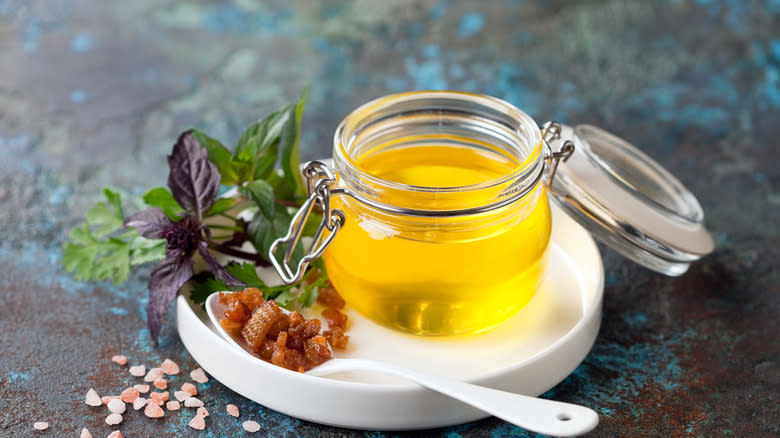
What fat are you cooking your fried chicken in? It's probably vegetable oil, right? That makes sense: Vegetable oil is a neutral-tasting fat that has a high smoke point, allowing you to cook your chicken at the high temperatures required without worrying about them taking on extra flavors. By using vegetable oil, though, you're missing out on a lot of possibilities to make your chicken richer and tastier -- and the oil swap you need to make for the most flavorful fried chicken is duck fat.
The main advantage of duck fat is its richness. This fat gives your chicken a deep, decadent flavor (part of why it's so good with roasted potatoes), which helps its seasonings to pop, while also producing a serious crispiness with its crust. Duck fat also has a smoke point of 375 degrees Fahrenheit, which is well above the temperature you need for fried chicken. It is worth mentioning, of course, that duck fat is substantially more pricey than bottled vegetable oil, so this likely isn't an everyday swap for most people. If you can afford it, though, you'll never want to make fried chicken another way again.
Use Flaxseed Meal Instead Of Eggs
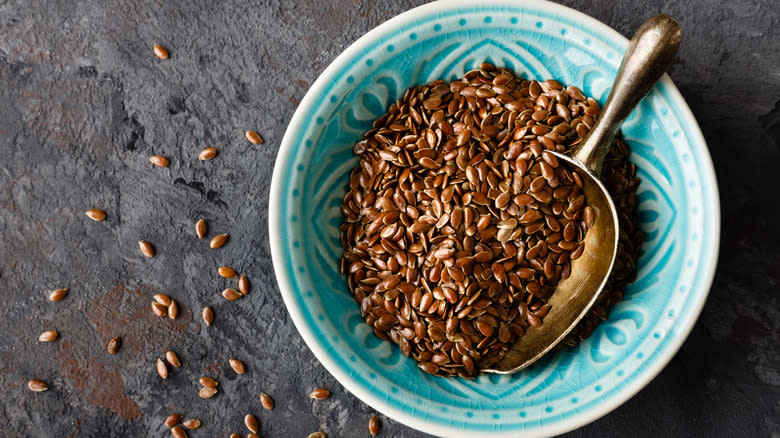
Some food swaps are pretty out there, but once you do them, you won't look back. Using flaxseed meal instead of eggs is one of them. This plant-based substitute isn't just good for folks who don't eat eggs. It can be used by anyone and is a quick way to give your chicken a nutty flavor while using up those leftover seeds at the back of your pantry.
Flaxseed meal has a gently tacky texture that's similar to beaten eggs, making it perfect as a base layer to which you add your breadcrumbs or flour. It also tolerates heat very well, meaning that you can hit it with the high temperatures needed to cook chicken and it'll still hold its own. Making flaxseed meal is surprisingly simple, too. You just have to grab some brown or golden flaxseed (whichever one you prefer), and an appliance that can break it down. If you're using smaller amounts, a coffee grinder will work best here. Larger batches can be made in your food processor blender, although bear in mind that you'll need at least a cup of flaxseed for this to work.
Swap Breadcrumbs For Breakfast Cereal
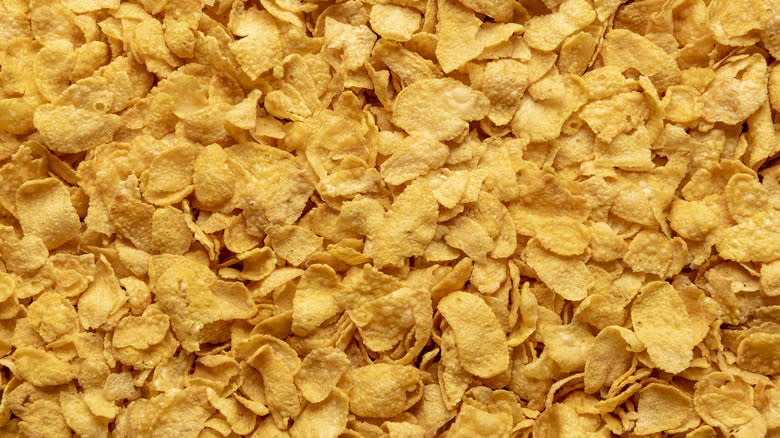
All of us love breakfast cereal, and all of us love fried chicken. So we honestly can't see any reason why you wouldn't combine the two. Okay, sure, so you may not want to coat your chicken with Fruit Loops, but there are loads of mild-flavored breakfast cereals out there that can give your fried chicken pieces high levels of crunch. They also have a malty, slightly complex flavor, which gives your chicken way more appeal than just using breadcrumbs.
Using breakfast cereal also gives your fried chicken way more texture, as when you break them down, they crumble into irregularly-sized chunks -- perfect for your oil to get around and crisp up. Wheaties are a great option to start with. Just place them in a Ziploc bag and bash them with a rolling pin (or the bottom of a skillet) until they're the desired consistency. Corn or Rice Chex are also great choices, as they can give your fried chicken a certain bubbly crispiness. If you don't have any of these on hand, you can't go wrong with Corn Flakes.
Ditch The Buttermilk And Use Yogurt
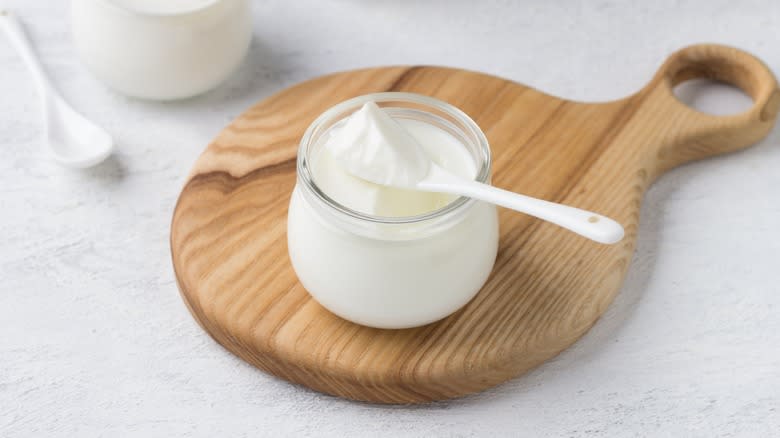
Buttermilk fried chicken is a thing of beauty. The acidity and creaminess of the buttermilk, combined with the salty, fatty crust and juicy chicken, you get hungry just thinking about it. There's only one way to improve buttermilk fried chicken, and that's to remove the buttermilk entirely and replace it with yogurt.
Yogurt elevates fried chicken thanks to its thickness. Whereas buttermilk is thin and runny, yogurt gives your fried chicken a certain amount of body and makes it easier for your seasoned coating to adhere. Yogurt also has an acidic, tangy flavor, which takes buttermilk's light acidity and elevates it to the next level. This gives your fried chicken even more dynamism, heightening the flavor contracts inherent to the dish.
When using yogurt, make sure you're going for the full-fat version. Fat-free yogurt doesn't have that same velvetiness, and will likely make your fried chicken taste a bit flat. If you find that your yogurt is too thick for your chicken, a splash of water or milk can help to thin it out. If you don't have yogurt, sour cream can also be an awesome substitute for buttermilk.
Sub Flour For Potato Starch
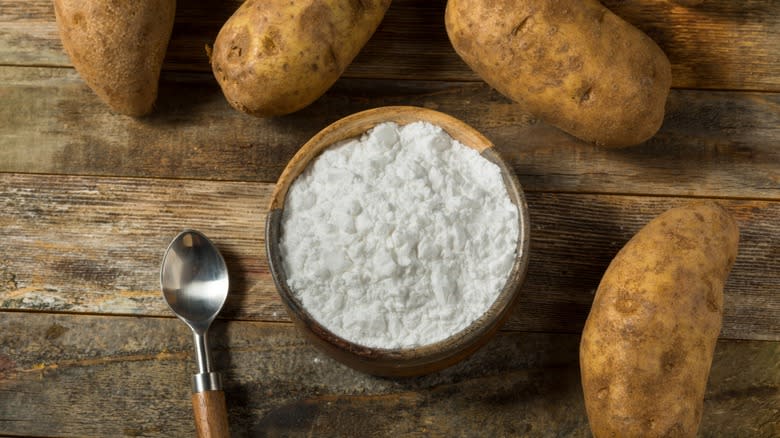
Just because wheat flour is most commonly used with fried chicken, that doesn't mean it's the best choice. If you want to try your hand at flavorful Japanese fried chicken, grab some potato starch. Potato starch is the backbone of karaage, a style of fried chicken defined by its light, crispy crust. Karaage is usually made with dark meat, but potato starch works well with any cut of chicken you like.
The benefit of using potato starch is not just how crispy it gets when cooked, but how long it stays crispy for hours. Karaage can stay full of crunch for a long time after you cook it, making this a great substitution if you're cooking chicken to take on the go. If you're going to go all-in on making karaage, though, you need to take another crucial step. Make sure you marinate your chicken beforehand (in a combination of soy sauce, sake, and mirin). This will give your chicken a deep, umami-rich flavor that will contrast beautifully with the light crust. Plus, using dark meat (if you're opting to do so) will give the chicken extra richness which balances the crispy coating perfectly.
Instead Of Buffalo Sauce, Use Sriracha For Your Wings
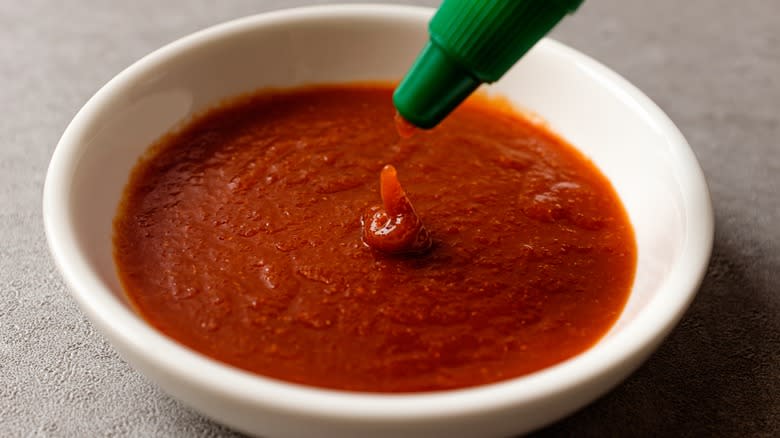
Hot sauce and fried chicken are a classic combo -- most notably when it comes to buffalo wings. This dish consists of deep-fried chicken wings coated in a spicy, vinegary, creamy sauce, providing an absurd amount of flavor and texture contrasts. There are times, though, when buffalo sauce on chicken wings can be overwhelming, and produce a claggy, unpleasant texture. Using sriracha will give your chicken wings a cleaner, sharper taste, while still providing that all-important hit of spice.
Sriracha packs a lot of complexity into a simple-looking sauce. In each dollop of the bright red condiment, garlic, chili, vinegar, and salt jostle for attention. There's also a slight fruitiness to sriracha, which gives your fried chicken unexpected elements. When combined with fried chicken, sriracha gives a lighter experience than buffalo sauce. Your wings won't feel as weighed down or messy, and your coating will be less likely to turn gummy and floury. Sriracha also pairs well with other hot sauces, and we would recommend mixing it with Tabasco or Cholula to give your meal even more flavor dynamics.
For Added Richness, Swap Your Eggs For Coconut Milk
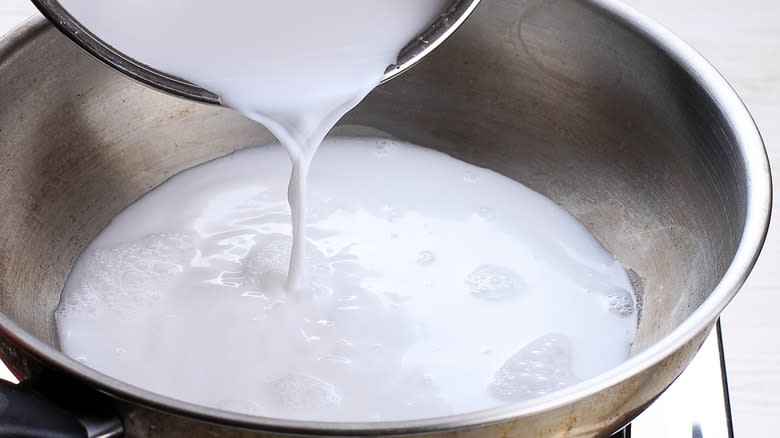
We're big fans of trying out new flavors in fried chicken and making a coconut-infused version might be our favorite. Coconut milk can make an excellent substitution for eggs in fried chicken, and give your meal floral, nutty notes that work unexpectedly well with your other flavors. Coconut milk's thickness allows it to stick to your chicken easily, and hold other ingredients in place. Its fatty nature simultaneously gives your chicken a juicy, smooth texture, and keeps it from drying out in the deep fryer.
When using coconut milk with fried chicken, you should be wary of a few things. The first is to never opt for light coconut milk. Not only is light coconut milk completely lacking in flavor, but it's also largely lacking in fat. It's this fat that works wonders with fried chicken, keeping it moist and helping your breadcrumbs stick to it. You should also check the ingredients in your coconut milk can before cracking it open. Some brands contain added sugar or salt, and you don't want to muddy your flavors too much with additives.
Read the original article on Daily Meal

 Yahoo Lifestyle
Yahoo Lifestyle 
